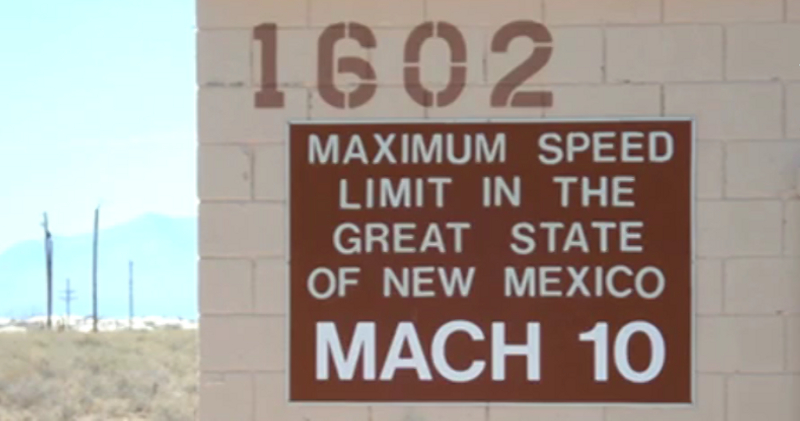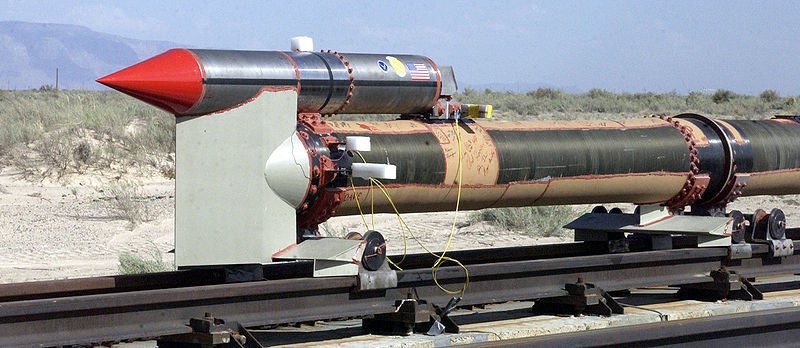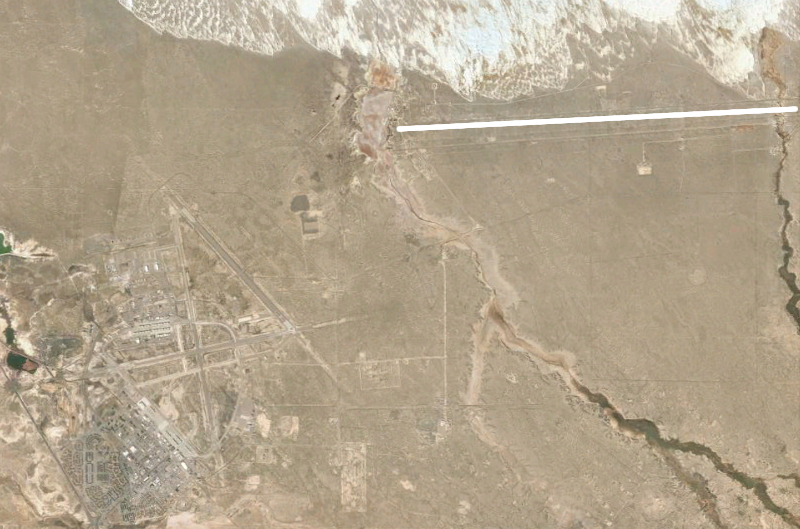
TARGET 120516
TRYING TO BREAK THE SPEED LIMIT
Mike Shinabery, who was a reporter for the local newspaper at the time, and I were invited to Holloman Air Force Base, outside of Alamogordo, New Mexico, to inspect the rocket that was designed to break the land speed record by reaching Mach 10. That speed had never been achieved before, and hopes were high. As we drove onto the range, we passed a sign that showed the speed limit they were trying hard to break.

In order to achieve their goal, they had equipped a rocket with eight huge boosters (not shown here). The boosters would kick the rocket to around Mach 4 in less than a second, at which time the booster (green tube) would kick in. As the rocket assembly reached around Mach 9, the final stage (sitting atop the booster) would fire its engine and, already starting at a speed of Mach 9, would take off from there, to break the land speed limit of Mach 10.

The fastest thing on landThis was not a waste of tax-payers' money, just to achieve a speed record. It was part of a necessary test of extremely high-impact equipment. In fact, one of the main reasons the High Speed Test Track is such a valuable asset for research is because, unlike rockets that lift off into space, you can position cameras all along the track for an extreme amount of data recording. Also, the cost ratio for test track firing is about 1:100 compared to "lift-off" type of firing. A project that would cost $75 million at Cape Canaveral would cost $75 thousand here, and would actually result in a greater amount of data collection.
Mach 1 is the speed of sound through air. If an object tries to go faster than that speed, the air just can't move out of its way fast enough, so the air starts acting like a liquid. At higher Mach speeds, it begins to act like a solid. In effect, it becomes like running into a brick wall. The "sonic boom" you hear as a result is, in effect, air breaking into pieces as the object plows through it. Reaching Mach speed is easy. In fact, the "crack" of a whip comes from the tip of the whip breaking the sound barrier. But to sustain a speed over Mach 1 is the equivalent of a bullet going through miles of water or concrete without stopping or slowing down. To reach and sustain a speed of Mach 10 has so far been the impossible speed limit to break.
While Mike and I were there, we signed out names onto the cork wrapper (the tan part shown in the photo, above) of the booster. All the names of the researchers and the firing team were also there.
Because birds and animals are out during the day, the rocket had to be fired at night. That is not out of a concern for the ecology. At speeds above Mach 6, the splitting of the air molecules can cause the metal of a rocket to melt and even catch on fire. Hitting a bird or even a large insect at that speed can virtually splatter the metal hull of the rocket and destroy the mission. So, for runs of this speed, the test is conducted at night when no animals will be in the way.

The rocket rode on tracks that are similar to railroad tracks, but of much sturdier steel. The track is, according to one survey, the flattest thing in the world. It was 10 miles long with less than 1/1000th of an inch of unevenness over the whole distance. Such a small tolerance is necessary because at the speeds the rockets travel, even 1/100th of an inch would be a huge bump and could throw the trajectory out of line.
The following video was taken from a distance of two miles from the rocket's target. The distance traveled was only 3.61 miles of the track, so the distance from the starting point to the camera is around 4 miles. In order for the rocket to reach Mach 10, it needed to go from 0 to almost 7 thousand miles per hour in that distance. The first boom you hear at the end was recorded by a microphone near the target. The following booms picked up by the microphone sound like echoes, but they are not. They are actually the sonic booms still catching up with the rocket.
About 1.2 of the way through the video, you will see the flame of the rocket suddenly narrow. That is the rocket entering a 2.77 mile long helium-filled balloon that had a circumfrence large enough for the rocket and sled. Helium is 1/7th the density of air, and the test was for a high-level atmospheric strike. So the helium-filled balloon was used to simulate the rarified atmosphere of near-earth space.NOTE: The video is almost silent because the sound of the rocket has not had time
to reach the microphone. Do not turn your volume up. The strike at the end is quite loud -
loud enough to shake buildings and rattle windows as far as 25 miles away.
As for Mike's and my signatures on the rocket, it is estimated that they lasted around 1/100th of a second before the heat of the passing air burned them into nothing more than a memory, existing only in a picture in my camera.
The economic savings to U.S. taxpayers by using the Holloman Test Track instead of a Cape Canaveral launch was approximately 74.25 million dollars.
But sadly, the rocket only achieved Mach 8.5. While that's pretty good - going from 0 to 6,589 miles per hour (For metric readers, that is ten thousand six hundred and four kilometers per hour) in around 6 seconds, it's still not breaking the speed limit at Holloman. Oh, well... maybe there will be another test that will let them try again.FEEDBACK MAP

An informational video (2 minutes 4 seconds) about Holloman Test Track can be seen here.
NOTE: The rail system is being replaced with maglev (magnetic levitation) tracks which present zero friction, allowing for much higher speeds.
If you got impressions for which this feedback is insufficient, more information,
pictures and videos can be found at the following web sites:
Google Earth view of the Holloman Test Track
Holloman AFB web site
Angie Palmer's web page (has pictures & information)
Note: All pictures and videos on this page have been released by and approved
for public dissemination by the Office of Public Affairs, Holloman AFB, New Mexico.
My private pictures of the signatures are close-up photos of the rocket and have not
been submitted for approval, so were not used.
Many thanks to Mike Shinabery for this target.